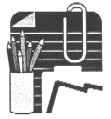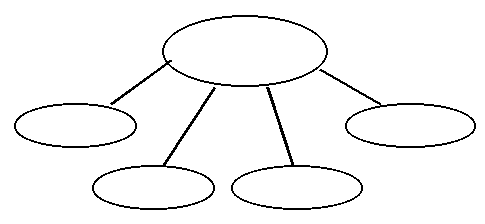 TRIZ
Textbooks: CID Course for Children, 1-1G1 TRIZ
Textbooks: CID Course for Children, 1-1G1 |
  
|
Topic 1.
What Does This or That Consists of?
(System is a whole, consisting of parts) |
Fairy Tales
School:
Course of Creative Imagination
Development (CID), 1st Grade, 1st Semester, Methodical Guide-Book |
Natalia
V. Rubina, 1999 [published
in Russian]
English
translation by Irina Dolina,
May 23, 2000
Technical
Editing by Toru Nakagawa, July
12, 2000 |
Posted
in this "TRIZ Home Page in Japan" in English on Jan.30, 2001 under the
permission of the Author.
(C) N.V. Rubina,
I. Dolina, and T. Nakagawa 2001 |
 |
TOPIC
1: WHAT DOES THIS OR THAT CONSISTS OF?
(System is a whole, consisting of parts) |
Workbook
Lesson 1.
1. Warming-up.
In "Card Index
to CID classes for the first grade" you will find a detailed list of finger
games, games for developing of perception, memory, child's emotional sphere.
"Card Index to CID
classes for the first grade" contains the tasks, where one has to match
the incompatible.
2. As a homework
check-up it might be useful to remember the characters of the Workbook,
we were introduced to at the previous lesson.
3. Introduction
to a lesson. A riddle, "yes-no" game, a magic trick and others
- anything that will interest the kids, involve them into a new topic.
In Flower city the
creature has appeared 
 with
the following mysterious description:
with
the following mysterious description:
on a brick two pieces
of cloth is hanging, there are knives to scare and to take food placed
in it, behind them one may see a pink leaf, at the end there is a black
shining button. Everything may have a meaning if you want to.
There is a cross-beam, placed on four hairy columns, with a small barrel
and a broom with an engine. All is covered by a rug. What is
this strange creature?
..........................(a dog)
This "mysterious description" is a
result of common work with the kids at one of the classes with a topic
"what does this or that consist of?"
To solve this riddle and learn how to devise
ones like that you will helped by Little One, who can see in the saddest
picture the cheerful sun, who can draw a familiar object in such a way
that nobody will recognize it, who can mix the colors to get the color
of happiness and sorrow.
Remember what his
name is. (Color Tube/ Tyubic)
4. Main topic.
 |
Disassemble the pen on your
table. You have got a few parts. Each of them separately can
not write letters in a word. If you assemble the parts again, you
will be able to write or draw anything. |
The kids must realize
that any system consists of the parts and has new characteristics. These
tasks will help them to understand that.
1. Show the system, with which you can
write. What parts do they consist of?
2. Contest: who will name more parts
of any system, or who will name more systems, that are in your class-room.
Many kinds of exercises
like that can be devised.
| A SYSTEM is a
whole, containing parts. A system may perform such a work that can
not be performed by its separate part. |
- Write or draw three systems: 
- And now try to give an example of subsystem.
- The air.
- Prove that it is a system.
- It has much dust.
- Right. The air is a mixture of gases.
- A coin.
- It is made of iron, its particles.
- The water.
- Why then is it being cleaned?
- Let's remember: everything that surrounds
us are systems
- What about the fire?
- It is hot and smoky. It has heat
and smoke.
5.
Psychotechnical games have come to CID classes from psychological training,
that allow to conduct in a very short period of time a diagnosis and a
correction of a kid. Of course, for conducting this serious work
we need a consultation with a school psychologist. But what is more
important is the fact that the atmosphere at the CID classes should be
friendly, that the kids should feel independent and relaxed, should not
be afraid of probing and making mistakes.
This game gives the
kids a possibility to realize that all the systems, even the most complicated
like a human being, consist of the parts. It is especially important
to the kids with a kinetic perception as a leading trend; so to say
they need to touch things they are studying to understand them better.
We have agreed that
everything in the world,  consisting
of parts, we call a system. We have found out that everything around
us are systems. All these dolls - Barby and Ken are also the systems.
consisting
of parts, we call a system. We have found out that everything around
us are systems. All these dolls - Barby and Ken are also the systems.
And now there is a task
for you. Would you stand up, girls. Imagine your Barby.
Which subsystem of this doll do you like best? Ready?
Now, boys, would you
stand up. Imagine your Ken. Which subsystem of Ken do you like
best? Ready?
Try to show the
part of the doll you have in your mind with the gestures. You are
not allowed to name it out loud. Do not hurry and do not prompt.
It is interesting who can express oneself with a language of gestures.
6. Exercises
on developing speech skills or producing a creative product.
In this part
of the lesson the kids have an opportunity to use their new knowledge,
to learn how to invent and to make something new. In this methodical
guide and in the "Workbook on CID classes" there are following tasks.
You may diversify the lessons, including in them the exercises on origami
or any tasks involving the work with natural materials. (It can be
ikebana, decoration, needlework, making toys etc.) Keep trying, and
what is the most important, you and the kids should realize which CID mechanism
in particular helps you to create something new.
| Parts of a system are
called Subsystems. |
| Think about a system.
What subsystems does it consist of? |
  |
| Write the subsystems' name |
Draw what do they remind you of. |
|
.
|
.
|
|
.
|
.
|
|
.
|
.
|
Now cover the left part
of the table. You have got a kind of a riddle for mysterious description.
Now present your riddle.
The form of
doing this exercise may be different. The kids can present their
riddles to the whole class or to some of the students. The best riddles
are worth noting specially.
Now it's time to present
a riddle of an artist. Insert the names of the subsystem, which the
artist has made up.
|
.
|
a brick |
|
.
|
two cloths |
|
.
|
knives |
|
.
|
a pink leaf |
|
.
|
a button |
|
.
|
a cross-beam |
|
.
|
four columns |
|
.
|
a small barrel |
|
.
|
a broom with an engine |
|
.
|
a rug |
7. Summing up.
It is very important
in the end of the lesson to mark out once more the main notions, that the
kids must remember for using in their further work.
In the riddled compiled by the kids it
is necessary to mark out the parts that help to understand what is the
thing we are talking about.
Workbook
Lesson
2.
1. Warming -up (Card Index for
the first grade)
2. Homework check-up.
Choose on your desk three
systems, which have similar parts or subsystems.
3. Introduction to a lesson.
"Yes-no" game. 
An Interview with the brothers:
- Are you brothers ?
- Yes.
- Were you born on the same day?
- Yes.
- Are you twins?
- No!
- Why?
(Triplets)
4. Major topic
Emil was asked to write  or
to draw parts of a cat:
or
to draw parts of a cat:
 |
--A system
subsystems |
Make two more sketches
of your favorite animals (look at the "Workbook on CID for the first class)
This graphical
sketch of a system and a subsystem helps the children with a dominating
visual perception to imagine an object and its parts, the children
with a kinetic orientation, using the sketch, also can better perceive
and remember it, the kids with a dominating audio-representative system
should be asked to retell how they fill in.
Do you know, why Emil always
copes well with the tasks like that? He is helped by his friend the
Sorcerer Deli-Davai*1 (Share and
Give). Deli-Davai can disconnect and connect everything.
*1 (Translation
Note:) 'Deli' and 'Davai' in Russian (spelled in Enlgish alphabets) mean
'Share' and 'Give', respectively.

Once Deli-Davai helped
to fill in a sketch and Emil began to retell such a funny story that the
Magician did not notice that he had mixed up the parts of different animals.
Draw the fantastic animal
that Deli-Davai managed to make.
Pay attention
to how a kid has coped with this work.
- Simple connection of the parts of the
different animals;
- Parts of the different animals are
supplemented and changed;
- On the bases of a familiar animal a
fantastic animal appeared;
- to complete the elements of the super-system,
in which a kid imagine this fantastic animal;.
This projective method
may give much interesting information about a kid.
Do you want right now in
your exercise to see a portrait of Deli-Davai? Draw a button
and a brush on the left and draw on the right what will become if
you will connect them.
"DELI-DAVAI":
Deli-Davai and Colabo
play in a word-game. Replying to the questions of the Sorcerer, do
not forget that the words, like all the systems consist of parts.
- What is there in a sea, in a lake,
in a swamp, in a ocean that is not found in a river?2
- A small flock was flying, how many birds
were there and what birds were in it?3
- Is there a letter "L" in a brush?4
Footnote 2
Answer: The letter
"O". *2
*2 (Translation
Note:) These four Russian words (spelled in English alphabets) are
'morye' (sea), 'ozero' (lake), 'boloto' (swamp), and 'okean' (ocean), and
have the vowel 'o' in common, whereas the Russian word 'reka' (river) does
not have it. In this sense, the answer for the above riddle in English
happens to be the letter 'a'.
Footnote 3
Answer: The seven
owls.*3
*3 (Translation
Note:) A small (flock) in Russian sounds like seven owls, because
'sovsem' (small) sounds like 'sova' (owl) and 'sem' (seven); thus this
small flock were "seven owls flock".
Footnote 4
Answer: For example, the
brush is covered with lacquer. *4
*4 (Translation
Note:) The Russian word 'kistochka' (brush) does not contain the
letter "L" by itself. But if the brush is lacquered, the Russian
word 'lockerovanaya kistochka' (lacquered brush) contains the letter "L".
5. Psychotechnical and developing games.
This game
gives the kids an opportunity to feel themselves one of those systems,
which they disassemble. The second part of the game is supposed to
set a problem that can be solved by combining the efforts of three or four
kids. The kids learn to work in a group. After this game
you may hold a discussion or give them an opportunity to express their
feelings, thoughts, conclusions in a drawing.
 Think about an animal. Show by the gestures, without sounds and words,
any recognizable part of this animal.
Think about an animal. Show by the gestures, without sounds and words,
any recognizable part of this animal.
Split into groups of 3-4
people. Choose any animal of those you have shown them. Show
all together how this animal moves and eats. The rest of the kids
guess what animal it is.
6. Exercises on developing of speech skills
or producing of a creative product.
 Tell about the fantastic animal you have thought of. If it consists
of a cat and a dog, what will it eat for lunch: cats like mice, and the
mice like cheese. What is the way out?
Tell about the fantastic animal you have thought of. If it consists
of a cat and a dog, what will it eat for lunch: cats like mice, and the
mice like cheese. What is the way out?
It is more
interesting to do this exercise in groups. The teacher has to direct
the kids' narration, asking questions.
7. Summing up the topic, check
up whether the kids understand how to apply the knowledge that everything
in the world consists of the parts.
Last updated
on Jan. 30, 2001. Access point: Editor: nakagawa@utc.osaka-gu.ac.jp


 with
the following mysterious description:
with
the following mysterious description:


 consisting
of parts, we call a system. We have found out that everything around
us are systems. All these dolls - Barby and Ken are also the systems.
consisting
of parts, we call a system. We have found out that everything around
us are systems. All these dolls - Barby and Ken are also the systems.



